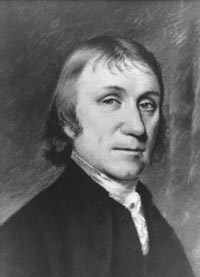
| Born: Mar 24 (O/S Mar 13), 1733 in Birstall, United Kingdom |
| Died: Feb 6, 1804 in Pennsylvania, USA |
| Nationality: English |
| Famous For: Discovery of Oxygen |
| Awards: Copley Medal |
Joseph Priestley was born on March 13, 1733, near Leeds, England. He was brought up in a strict Calvinist background. Majority of people knew him as an unorthodox philosopher because of his strong liberal beliefs that conflicted with the teaching of the church and also as an English clergyman who authored over 150 publications.
Priestley’s Early Life
Priestley proved to be the most intelligent child from an early age and he studied logic, natural philosophy, metaphysics and mathematics. He learned to speak and write in more than six languages including Greek, Latin, and Hebrew. His open and unpopular views about the French Revolution caused hundreds of angry protesters to burn his chapel and home in Leeds in 1791.
Achievements and Contributions
Priestley is highly noted for his innovative contributions to electricity, experimental chemistry and the chemistry of gases that are of biological significance. He brought up to 10 gases to his list including oxygen, nitrous oxide, hydrogen chloride, carbon monoxide and nitrogen. He later conducted a series of experiments to distinguish each gas based on its properties.
Documented Photosynthesis in Plants
One of Priestley’s best known achievements in the field of biology in 1772 was his work with photosynthesis. He achieved this by placing a shoot of a green plant in a container with water which he then covered. He then lit a candle inside the jar and it burned out completely.
In a later experiment, Priestley burned the candle in the jar and put a mouse inside as well. Both the plant and the mouse stayed alive. In this regard, Priestly became the first person to discover and observe the process of photosynthesis in green plants. He then based his observation on the fact that the plants took in carbon dioxide and released oxygen as a byproduct.
In a subsequent experiment to confirm the process of photosynthesis, he realized that the green matter that grew in the walls of his jar produced a certain gas upon exposure to sunlight. He identified this gas to be the same gas that was produced by the shoot of the green plant.
Discovery of Nitrous Oxide
In 1772, Priestley devised a new apparatus that he used to collect gases over mercury. It was with this device that he made another discovery that has been highly appreciated by surgeons worldwide – nitrous oxide. This gas had quite unusual effects on people. For one thing, it made them laugh upon inhalation, which is why it is commonly referred to as laughing gas. Due to its effects on people, this became the first surgical anesthetic.
Carbon Dioxide
Priestly was quite intrigued by the air that floated over the fermenting grain in the brewery next to his church. From his experiments, he was able to deduce that this brewery gas extinguished a lighted wood chip and was heavier than normal air. He later designed an experiment to produce the same gas in his lab. He also noted that the gas produced a tangy taste when dissolved in water which led to his invention of the first drinkable glass of carbonated water (soda water).
Later Life and Death
In 1794, Priestley immigrated to the United States with his family and settled in Northumberland, Pennsylvania. He later retired to a peaceful life with his writings. He died quietly in his home on February 6, 1804.